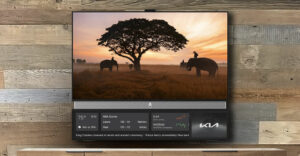
The tumultuous convergence of entertainment devices, greater interaction with the television-viewing experience, and increased involvement of social networks were all in the Klieg lights at the IP&TV World Forum, the Internet television show I attended recently in London.
I was immersed in the future of television content delivery mashed with user interaction. Here’s a rundown of some of the show’s highlights, along with an explanation of some of the more interesting technologies and a look at the state of play today.
Dual-Screen Engagement
If there’s one thing that stood out at the show, it was dual-screen engagement — meaning the use of tablets and phones (called the “second screen,” or “companion device”) in conjunction with televisions. We’re seeing a significant uptake in the use of additional screens while watching TV.
They are being used as viewing screens, remote controls, and as devices for researching and socializing.
The screens are being supplied by TV equipment providers, and also purchased independently (tablet and phones) by consumers themselves.
Barriers to Dual Screen
The second screen still lacks a full content lineup. Pay TV providers should meet the challenge to not just optimize the companion experience, but own it, said Derrick Frost, senior VP of global IP video for Alcatel-Lucent, who presented a panel on “Optimizing the Companion Experience.”
“The runaway success of the companion tablet has brought control, context and social communications to the viewing experience,” Frost told TechNewsWorld. “Now it is time to focus on the content, and remove the walls that prevent some content to be streamed to the companion device.”
OTT Video
Over-the-Top video (OTT) refers to Internet-delivered content. Netflix, a heavyweight in the U.S., and Amazon’s Lovefilm in the UK are examples of the genre.
Delivery is by PC, tablet, phone, television — including smart TVs (those with Internet connectivity) — and uniquely OTT products like set-top box Roku. Classic Pay TV content is generally being moved to the cloud.
Hybrid Content
A mix of broadcast and Internet-delivered content is called “Hybrid.” Video on Demand (VoD) delivered over the Internet, coupled with classic cable systems or over-the-air broadcasts, is an example of this technology.
EPGs (electronic program guides) are being taken very seriously in this medium, and are looked on as differentiators between classic and OTT delivery. Look for upcoming innovative EPG solutions.
Hbb-Next, a European hybrid system that’s synchronized between broadcast and Internet, may end up stateside. It is likely to include facial recognition and other search tweaks.
Disruptive Technologies
Google TV, an aggregator of OTT mixed with search and pass-through to classic delivery mechanisms like cable, does not fit into any of the above categories.
Apple’s ballyhooed next-generation Apple TV is also likely to be disruptive, and momentum that has been gained with the iStore can be harnessed.
Upcoming Super Chips
New chips are coming, designed for the interactive connected TV platform. They are designed to provide better video and improved audio. One maker is Marvell, which is producing Google TV’s next generation of silicon.
“Marvell envisions that interactive TV will become the command center for our connected lifestyles,” said Hanna Kang, brand manager for Marvell’s digital entertainment business unit.
“There has been a fundamental shift in the relationship between the producers and consumers of content,” Kang told TechNewsWorld, “creating a dynamic, two-way experience featuring real-time global news, social network, entertainment and information. The same forces that are revolutionizing today’s television experience will transform numerous vertical applications for small businesses and large enterprises, enhancing the way we all work, connect with each other and collaborate globally.”
Fragmentation of Delivery
Fragmentation of delivery is likely to become even more prevalent than it has been, with multiple major players looking to get into the game.
The HTML5 standard may steamroll over some existing products.
Facebook and Twitter
Wry textual observations made by viewers while watching television using social networks like Twitter are here to stay — as are all aspects of social viewing.
“Watching television is rapidly evolving into a social experience, with users in charge of the timing of the content they want to watch, accompanied by a desire to share the viewing experience with their friends,” Dov Moran, CEO of Comigo, told TechNewsWorld.
State of Games Console
Games are being delivered via TV, tablet and phone now.
We’re seeing classic game consoles that have surreptitiously been a way to get Blu-ray players into homes — like Xbox and PlayStation — become suitable OTT delivery mechanisms.
Tablets and phones may replace games consoles. On-demand cloud gaming provider OnLive is a player in this area.
Mobile Apps
Mobile apps on the second screen that react to watermarked audio and launch targeted content are beginning to appear.
UK broadcaster Channel 4 has just made available its second screen iOS application for a fee.
Episodes of the show “Facejacker” are embedded with sub-audible tones that allow content to be unlocked on the second screen.
Content Delivered via the Web
YouTube is the still the frontrunner in this area, with broadcasters often uploading video to YouTube at the same time that it’s uploaded to its catch-up service.
Personal channel-building functionality for users, along with the more common social network mashing, is included. In addition to YouTube via PC, we are seeing YouTube apps in TVs, smartphones and tablets that can be squirted over to the TV.
These websites are also blurring the lines between those that have historically provided the content and the viewer, with the viewer — in the case of YouTube and others — supplying the content.
The Numbers
“By the end of 2015, consumers will have an array of ways to engage with TV services, both on and off their TV screens,” predicted Rob Gallagher, principal analyst and head of broadband and TV research at Informa Telecoms and Media.
“Nearly 1.5 billion connected TVs, games consoles and other Internet-enabled TV devices will have been sold, 1.7 billion people will use smartphones, and 372 million will own tablets,” Gallagher told TechNewsWorld. “This proliferation of devices will greatly expand and enhance the ways in which consumers discover, watch, interact with and talk about TV, creating opportunities and threats for established and wannabe TV industry players alike.”





















































